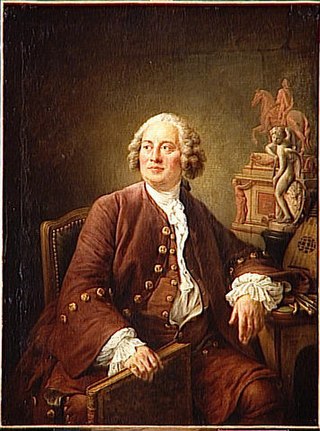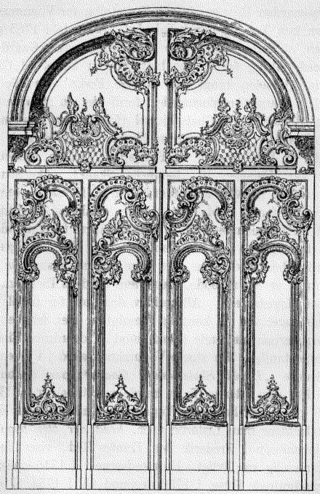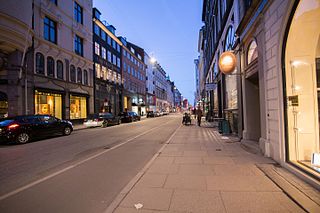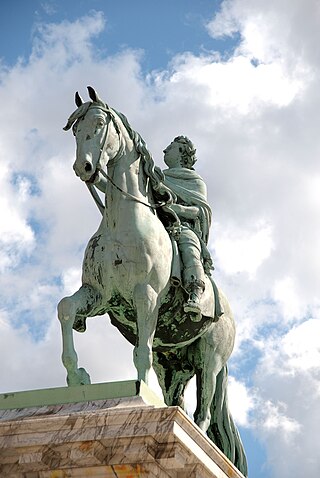
Frederick V was King of Denmark and Norway and Duke of Schleswig-Holstein from 6 August 1746 until his death in 1766. A member of the House of Oldenburg, he was the son of Christian VI of Denmark and Sophie Magdalene of Brandenburg-Kulmbach.

Amalienborg is the official residence for the Danish royal family and is located in Copenhagen. Frederick VIII's palace complex has four identical Classical façades, effectively four palaces, with Rococo interiors, laid around an octagonal courtyard. At the centre is a large equestrian statue of Frederick V. Amalienborg was originally built for four noble families, but after Christiansborg Palace burned in 1794 the royal family bought the palaces and moved in. Over the years various monarchs and their families have lived there, including today's King Frederik X and Queen Mary.

Edmé Bouchardon was a French sculptor best known for his neoclassical statues in the gardens of the Palace of Versailles, his medals, his equestrian statue of Louis XV of France for the Place de la Concorde ; and for the Fountain of Four Seasons in Paris. He was also a draftsman and painter, and made celebrated series of engravings of working-class Parisians.

Count Adam Gottlob von Moltke was a German-born Danish courtier, politician and diplomat who was a favourite of Frederick V of Denmark-Norway. Moltke was born at Riesenhof in Mecklenburg. His son, Joachim Godske Moltke, and his grandson, Adam Wilhelm Moltke, later served as Prime Minister of Denmark.

Johannes Wiedewelt, Danish neoclassical sculptor. He became a court sculptor, introducing neoclassical ideals to Denmark in the form of palace decorations, garden sculptures and artifacts and, especially, memorial monuments. He was undoubtedly the best known Danish sculptor before Bertel Thorvaldsen.

Louis August le Clerc, also known as Louis-Augustin le Clerc, was a French-born sculptor working in Denmark. He was born in Metz, France to copperplate engraver Sebastian le Clerc and his wife Charlotte van den Kerckhove. He was summoned to Denmark at the age of 47, and lived out the rest of his life there as a royal sculptor to the Danish Court and as professor at the Royal Danish Academy of Art. He helped introduce French Rococo artistic ideals to Denmark.

Jacques François Joseph Saly, also known as Jacques Saly, French-born sculptor who worked in France, Italy and Malta. He is commonly associated with his time in Denmark he served as Director of the Royal Danish Academy of Art (1754–71). His most noteworthy work is the equestrian statue Frederik V on Horseback at Amalienborg.

Nicolai Eigtved, also known as Niels Eigtved, was a Danish architect. He introduced and was the leading proponent of the French rococo or late baroque style in Danish architecture during the 1730s–1740s. He designed and built some of the most prominent buildings of his time, a number of which still stand to this day. He also played an important role in the establishment of the Royal Danish Academy of Art, and was its first native-born leader.

Caspar Frederik (Friedrich) Harsdorff, also known as C.F. Harsdorff, was a Danish neoclassical architect considered to have been the leading Danish architect in the late 18th century.

Nicolas-Henri Jardin was a French architect. Born in St. Germain des Noyers, Seine-et-Marne, Jardin worked seventeen years in Denmark–Norway as an architect to the Danish royal court. He introduced neoclassicism to Denmark–Norway.

Moltke's Palace or Christian VII's Palace is one of the four palaces of Amalienborg in Copenhagen that was originally built for Lord High Steward Adam Gottlob Moltke. It is the southwestern palace, and since 1885, has been used to accommodate and entertain prominent guests, for receptions, and for ceremonial purposes.

Frederiksstaden is a district in Copenhagen, Denmark. Constructed during the reign of Frederick V in the second half of the 18th century, it is considered to be one of the most important rococo complexes in Europe and was included in the 2006 Danish Culture Canon.

Bredgade is one of the most prominent streets in Copenhagen, Denmark. Running in a straight line from Kongens Nytorv for just under one kilometre to the intersection of Esplanaden and Grønningen, it is one of the major streets in Frederiksstaden, a Rococo district laid out in the middle of the 18th century to commemorate the tercentenary of the House of Oldenburg's accession to the Danish throne. It is lined with a number of fine mansions as well as other historic buildings. Many law firms, trade unions, fashion stores and art galleries are based in the street. The street also runs parallel to the Royal residence Amalienborg and Frederik's Church

Danish sculpture as a nationally recognized art form can be traced back to 1752 when Jacques Saly was commissioned to execute a statue of King Frederick V of Denmark on horseback. While Bertel Thorvaldsen was undoubtedly the country's most prominent contributor, many other players have produced fine work, especially in the areas of Neoclassicism, Realism, and in Historicism, the latter resulting from growing consciousness of a national identity. More recently, Danish sculpture has been inspired by European trends, especially those from Paris, including Surrealism and Modernism.

Johan Christoph Petzold was a German sculptor who mainly worked in Denmark. He was a professor at the Royal Danish Academy of Fine Arts from its establishment in 1754 and briefly held the post of Sculptor to the Danish Court.

Carl Marcus Tuscher was a German-born Danish polymath: portrait painter, printmaker, architect, and decorator of the Baroque period.

The Equestrian statue of Frederick VII in front of Christiansborg on Slotsholmen in Copenhagen, Denmark, was modelled by Herman Wilhelm Bissen and completed posthumously by his son Vilhelm Bissen in 1873. It was created to commemorate King Frederick's central role in Denmark's transition from absolute to constitutional monarchy.

Amalienborg Square, Copenhagen is an 1896 oil-on-canvas painting by the Danish artist Vilhelm Hammershøi in the Statens Museum for Kunst.
























